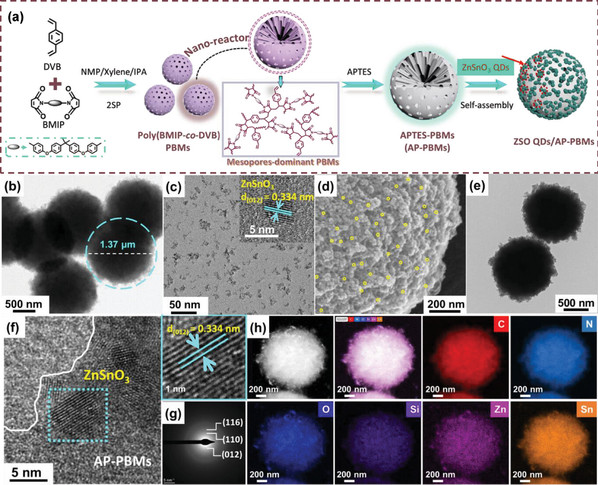Self-Floating Polymer Microreactor for High-Efficiency Synergistic CO2 Photoreduction and Antibiotic Degradation in One Photoredox Cycle
Mengmeng Wang1, Yingxue Zhang1, Shihong Dong2, Najun Li1, Qingfeng Xu1, Hua Li1, Jianmei Lu1(路建美)*, Dongyun Chen1(陈冬赟)*
1Collaborative Innovation Center of Suzhou Nano Science and TechnologyCollege of Chemistry Chemical Engineering and Materials ScienceSoochow University199 Ren’ai Road, Suzhou 215123, P. R. China
2Suzhou Shijing Technology Co., Ltd58 Jinrui Road, Suzhou 215137, P. R. China
Adv. Funct. Mater. 2024, 34, 2408831
Abstract:Constructing a novel photocatalyst to realize both pollutant oxidation and evolved CO2 reduction in one photoredox cycle can significantly reframe the role of pollutant management. Here, self-floating poly(bismaleimide-co-divinylbenzene) porous microspheres (PBMs) are filled with ZnSnO3 quantum dots (ZSO QDs) to construct a polymer composite microreactor with an S-scheme heterojunction (ZSO QDs/AP-PBMs). This microreactor realizes efficient catalytic oxidation and degradation of antibiotic pollutants under light, and the CO2 generated in this process is reduced to high value-added CO, allowing for the direct conversion of pollutants to a resource in one photoredox cycle. The high specific surface area of the PBMs enables the rapid and efficient adsorption of levofloxacin (LVX), and the self-floating porous design effectively solves the problem of CO2 adsorption and mass transfer in the gas–liquid–solid three-phase system, while the S-scheme heterostructure enhances charge carrier separation. As a result, ZSO QDs/AP-PBMs achieves complete degradation of LVX in one redox cycle with 100% selectivity to produce 100.3 µmol g−1 CO, and further draw a conclusion that fluoroquinones antibiotics as excellent electron donors can significantly enhance co-catalytic effect with CO2, which is not previously reported. Theoretical calculations and characterization experiments provide information on S-scheme heterojunction transfer mechanism and possible degradation pathways, allowing for the rational design of photoredox bifunctional catalysts.

链接://onlinelibrary.wiley.com/doi/10.1002/adfm.202408831